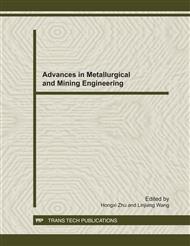p.90
p.96
p.100
p.107
p.111
p.116
p.123
p.132
p.138
Causes and Countermeasures of Cracking in Cogging Process of 40Cr Bloom
Abstract:
This paper has analyzed the solidification structure and thermodynamic state of bloom by means of the electron microscopy observation and heat transfer model, and studied the cracking mechanism and influence factors in the cogging process of 40Cr bloom. The results show that the main cracking reasons are the unreasonable secondary cooling scheme, the high reheating temperature in the bloom surface, the coarser grain and widmanstatten structure of the bloom subsurface. When the bloom is conveyed from the steel mill to rolling mill, the bloom may crack for the phase transition stress and thermal stress, some micro-cracks occur in the bloom surface, furthermore, the crack will expand when it is heated in the heating furnace and rolled in the cogging mill, the cracking occurs in bloom eventually. In order to reduce the bloom cracking in the cogging process, it must optimize the secondary cooling system, reduce the cooling intensity, and adopt the thermal insulation, hot delivery and hot charge process. If the bloom can not be conveyed in the hot delivery and hot charge mode, it should be conveyed to the slow cooling pit.
Info:
Periodical:
Pages:
111-115
Citation:
Online since:
November 2011
Authors:
Keywords:
Price:
Сopyright:
© 2012 Trans Tech Publications Ltd. All Rights Reserved
Share:
Citation:


